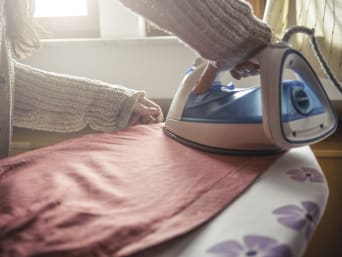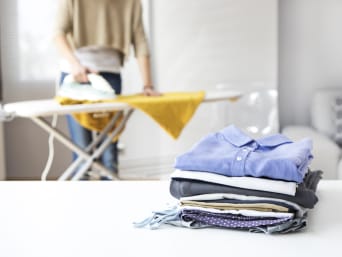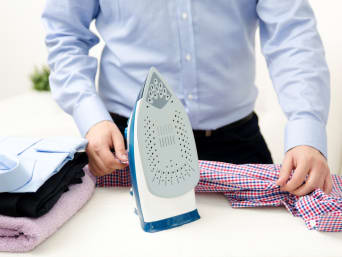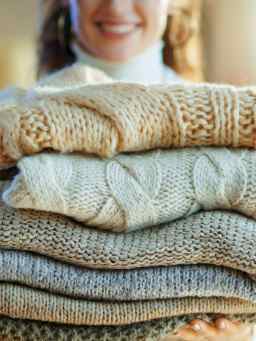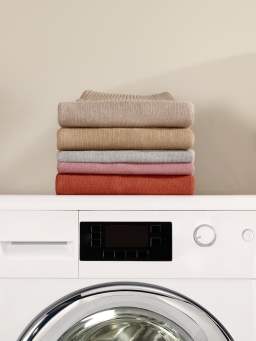Essential ironing tips
Most people do not enjoy doing ironing, but with a few helpful tips you can save time whilst ironing. We will show you which techniques and tricks make ironing quicker and easier. By ironing correctly you can protect the material of your clothes meaning that you can enjoy them for longer.
In the following article we will show you how you can easily and quickly get crease-free clothes and what you should be aware of when ironing different materials. We will also give you some tips on how to stop your clothes from becoming creased when you're on the go.
3 tips for stress-free ironing
You can find out whether an item of clothing is suitable for ironing by checking the care label. If the iron symbol is crossed out, you should not iron that particular item of clothing. If the symbol is not crossed out you can iron it.
Stress-free ironing tip 1: washing should still be slightly damp
To make ironing easier it is important to make sure you dry bed linen, towels and the like correctly. The drier the washing is, the harder it will be to iron. It is easier to iron washing when it is still slightly damp. If they are dry, you can simply give them a quick spray with some water or use a damp cloth.
Tip: If you use a tumble dryer you can select the setting "Iron Dry".
Stress-free ironing tip 2: ironing at the correct temperature
To set the right temperature on an iron, you should first take a closer look at the care label. The care label will not only tell you whether a certain material can be ironed, but it will also show you which temperature it should be ironed at. One dot on the iron symbol means that the material may only be ironed on a low heat. If there are two dots on the iron symbol, you should use a medium heat. You can iron your washing on the highest setting if there are three dots on the iron symbol.

In general, synthetic fibres such as nylon or viscose and delicate fabrics for example, silk and wool should only be ironed on a low heat. However, cotton and linen are quite heat resistant which means they can be ironed at a higher temperature.
Stress-free ironing tip 3: ironing delicates and dark fabrics inside out
Some dark fabrics should be turned inside out before they are ironed as they can get shiny ironing marks. Delicate prints or clothes with sequins should also only be ironed inside out. Prints or sequins usually cannot withstand the heat. When they are ironed there is a danger that the print may stick to the iron.
How to iron clothes
Towels or bed linen can be ironed quite easily due to their large surfaces, however, some items of clothing can be trickier to iron such as shirts, blouses and T-shirts. It is important to use the correct ironing technique to get the best results. By following the right tips your suit can also be ironed quickly and easily.
Before ironing make sure to dry your clothes properly. If you leave your clothes to air dry it is best to hang up shirts and jumpers on a hanger. Before hanging them up make sure to give them a little shake because this will help to smoothen out the fibres and save you time when you iron them. If you use a clothes horse to dry your clothes hang them up with the hem facing upwards. The pressure points from the clothes pegs are easier to iron out from the hem rather than around the shoulder area.
How to iron T-shirts
Before ironing T-shirts or jumpers always make sure to turn them inside out. This is especially important if clothes have any sequins or prints on them.
Firstly, stretch your T-shirt over the ironing board, as this will help to keep the fabric crease-free. Now gently glide the iron over the T-shirt and apply a little bit of pressure. It is important to keep the iron moving to prevent any burns. Now you can fully iron the T-shirt by pulling it around the ironing board bit by bit. When you have finished, turn your T-shirt right side out again and iron the sleeves from both sides. If you have made a crease whilst ironing, you can simply tighten the part of the clothing on the ironing board and iron over it again.
How to iron shirts
For many people getting a crease-free shirt is the ultimate challenge when it comes to ironing. Using an ironing aid and a sleeve board are important for ironing shirts. It is easier if you start by ironing the collar, shoulders, placket and sleeves on the shirt. Otherwise, you run the risk of the longer parts of the shirt becoming creased again.
Start off by ironing the underside of the shirt collar and iron from the centre to the edge. Now turn the shirt the other way round and iron the other side of the collar.
To iron the shoulder area crease-free, first open the shirt and place the inside part of the shoulder over the top of the ironing board. Now you can carefully straighten out the shirt all the way down to the collar.
You can iron the sleeves on a sleeve board and this is easier to do afterwards. Put the sleeves on the small board and iron around them. Before you iron the button placket, make sure none of the buttons are fastened. Now turn the shirt over and slide the iron along the inside of the button placket. Afterwards turn the shirt over again and carefully run the tip of the iron between the buttons.
Finally, iron the longer parts on the front and back of the shirt. To do this, place one side of the shirt on the ironing board and gently iron them until there are no creases.
5 tips on how to iron clothes without an iron and ironing board
Ironing is quick and easy when you use the correct technique. However, there are situations where you don’t have an iron or an ironing board and you need to get rid of some creases. We'll show you a few clever tricks for crease-free clothes.
Ironing without an ironing board
An ironing board is practical, but there are plenty of other handy everyday alternatives that you can use. For example, a flat surface is quite sufficient such as a table or the seat on a chair. However, remember to protect the surface before ironing. This can be done by placing a towel over the surface.
Ironing without an iron
Here is a helpful tip on how to iron without an iron. You can use a hairdryer or hair straighteners. Simply hang up the item of clothing and make it slightly damp and then use the hair dryer on a low setting. Hair straighteners can also be used to quickly straighten out shirt collars or sewn on pockets. However, make sure that the hair straighteners are not too hot and that they don’t have any residue of hair products on them.
Save time whilst ironing
Simply place some aluminium foil under the ironing board cover. This will reflect the heat, which will allow you to iron both sides at the same time.
Hanging up clothes in the bathroom
If you don't want to use an iron. It’s a good idea to hang up your blouse in the bathroom if you would like to get rid of the creases. Steam and heat will help to remove some of the creases. This method is also great if you don’t have an iron such as when staying at a hotel.
Keeping your clothes crease-free whilst travelling
Whilst travelling clothes can become creased in your suitcase. It’s important to pack your suitcase correctly by rolling up your clothes instead of folding them as this will help to prevent any creasing. After arriving you can simply hang up your clothes, which will keep your clothes crease-free.
How to descale an iron
It’s important to take care of your iron so that you can have crease-free clothes. Therefore, it is recommended to clean and descale your iron regularly. To clean your iron you can use some oven spray for removing burn stains, which is unfortunately not suitable for aluminium soles. Lemon juice is a fantastic home remedy for cleaning the soleplate on a coated steam iron. Simply apply some lemon juice to the stains on the iron with a soft cotton cloth and leave to soak for a short while and then the stains will come off. The final step is always to dry it and give it a polish. However, citric acid is only suitable for cleaning the outside of an iron. Citric acid must not be heated otherwise deposits may form and clog the nozzles and pipes on your iron.

Descaling an iron
There are two options for descaling an iron. Either use a descaler or use some vinegar to remove the limescale. Some irons even have a self cleaning function, which makes descaling and a cleaning a lot easier. However, make sure to check your iron’s user manual for further detailed information.
Conclusion: ironing made easy
Getting crease-free clothes is quite easy all you need is the right technique and setting on your iron. It is a lot easier to iron if the washing is still slightly damp. The correct technique is very important especially when it comes to ironing shirts. Always make sure to check the care label on your clothes before ironing. Checking the symbols on the care label and being aware of the type of material the item of clothing is made out of will determine which temperature and setting you should use on your iron.
______________________________________________
The image sources in this text are in chronological order
Cover photo: iStock.com/sestovic
1 Image in text: iStock.com/andresr
2. Image in text: iStock.com/seb_ra
3. Image in text: iStock.com/simpson33
4. Image in text: iStock.com/sestovic
